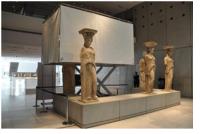 Add My Company
Add My Company
Sign In

Scientists carrying out restoration work in the Acropolis in Athens, Greece are using Lasermet‟s laser blocking curtains to set up a laser laboratory in the public area. The curtains provide a cost effective and easily portable method of laser blocking enabling the laser Restoration work to continue. The Laser-Blocking Curtains are made from Lasermet's own specially developed laser-blocking material which is supplied ready-made as either a ceiling or wall-mounted curtain. As the material is white on one side and black on the other, it will operate as a blackout blind / screen as well as a laser-blocking screen. Both sides block laser radiation although if the white side is used as the laser-blocking side an even higher specification of blocking will be achieved, making it suitable for higher powered lasers. The material is fireproof and is certified to EN60825-4:1999 Public sees laser restoration at the Acropolis; 09 Mar 2011 Caryatid sculptures are treated with a dual-wavelength system in a public viewing area at the Acropolis Museum in Athens. Scientists have set up an advanced laser laboratory in a public area of the Acropolis Museum in Greece, allowing visitors to view how the technology is being used to restore ancient sculptures to their former glory. The customized laser system has already been used to restore priceless objects including the Parthenon West Frieze and the Metopes, but this is the first time that it has been open to the public. Lasermet‟s certified laser blocking curtains offer laser safety protection for the public. According to the specialist team from Costas Fotakis' group at the Institute of Electronic Structure & Laser (IESL-FORTH) in Crete that is carrying out the restoration, the combination of a fundamental 1064 nm and a frequency-tripled 355 nm beam from an Nd:YAG system is able to remove thick layers of pollution that have accumulated over nearly 25 centuries, without discolouring or damaging the marble surfaces below. The infrared/ultraviolet technique has been in use for many years now, after initial attempts using just the fundamental wavelength caused a yellow discolouration. In situ preservation Although similar artefacts have been restored with the dual wavelength system previously, this is the very first time that such treatment has been applied to the Caryatids, which were moved from their original site at the Acropolis to the museum as recently as 1979. “The museum policy was to avoid any risky transportation of the masterpieces to a conservation laboratory, and instead perform any preserving activities in-situ,” explains the FORTH team. To house the laboratory, the team built a special platform to “embrace” the sculptures and move them to different heights, so that the conservationists obtained optimum access along the surface of the sculptures. The platform is surrounded by protective curtains from Lasermet to block any laser beams and to meet health and safety requirements. The Caryatids are a set of six female statues that were used in place of conventional columns to support the roof of the south porch of the „Erechtheion‟, regarded as the most sacred part of the Acropolis temple complex. According to the Acropolis Museum, the figures were separately carved in Parian marble and fixed onto slabs of grey Eleusinian limestone.
For more information on Lasermet’s laser blocking curtains used by Scientists in the Acropolis, Athens talk to Lasermet
Enquire Now
More related to Lasermet’s laser blocking curtains used by Scientists in the Acropolis, Athens
List your company on FindTheNeedle.

